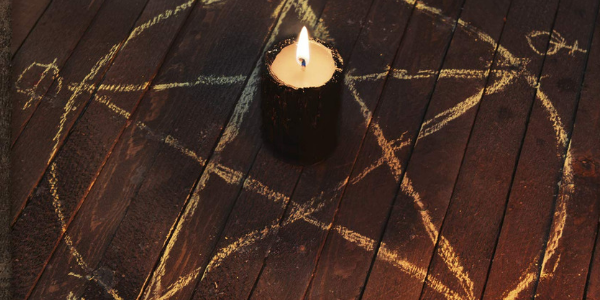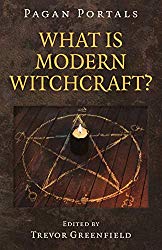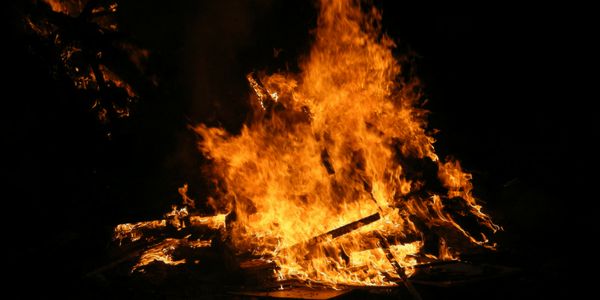
What is Modern Witchcraft?: Contemporary Developments in the Ancient Craft, edited by Trevor Greenfield
Moon Books, 9781785358661, 97 pp., 2019
A book that claims to discuss modern witchcraft in 2019, that’s completely western Eurocentric and literally makes no mention of race or intersectionality? Is this a hoax? No, sadly it’s not. Welcome to What is Modern Witchcraft?: Contemporary Developments in the Ancient Craft edited by Trevor Greenfield. This slim volume includes 11 essays written by witches writing from Celtic and English traditions, from classic to contemporary witchcraft. Frankly, I was disappointed in this book, and I doubt readers will glean anything new that we haven’t read elsewhere. The nature of short essays on a broad topic is that it can be difficult for writers to create context and explore any topic in depth. The result here is a volume that lacks comprehensiveness and cohesion.
Thinking about context points to a critical issue with this book — it doesn’t introduce the reader to the essayist in an easy way. It might sound like a petty quibble, but if you’ve created a short book comprised of nothing but essays from disparate authors, you really need to orient your reader to who they’re reading! The editor here is Trevor Greenfield who is the publisher (and publicist) for Moon Books (the book’s publisher). Moon Books is an occult imprint of John Hunt Publishing and as such is the host of a series of occult books titled “Pagan Portals” and each covering a different topic; I’ve reviewed two books from the series for Spiral Nature Magazine: Candle Magic: A Witch’s Guide to Spells and Rituals by Lucy Starza, and Hekate: A Devotional by Vivienne Moss.
Now, I love a good introductory Pagan book. When they’re done right, they are amazing — a concise and well written springboard from which to delve deeper into a given topic. However, this book isn’t an introductory text; it’s more like a snapshot of modern witchcraft, through the various lenses of each writer’s perspective. Perhaps that’s why, although short, it’s a little disorienting to read. I kept pausing as I read, trying to figure out what I had missed that would help me glean some perspective with which to parse each author’s words.
The authors’ biographies are all collated at the back of the book. I’m more accustomed to biographies being located at the end of each essay in this type of edited book. However, for this book, I would have preferred the biographical information right at the start of each essay. There are a handful of essays with very specific temporal or geographical perspectives. I’m thinking of Melusine Draco (“Old Craft for a New Generation”),1 who is a staunch British Traditional witch, or Amie Ravenson (“Web Weaving for the Modern Witch”),2 who has a more modern, eclectic style and whose essay focuses on cyber witchcraft. Unfortunately for the reader, without some introduction to the author or some editorial thread that could weave these essays together, they just read as disconnected and disorienting.
To be blunt, I wasn’t sure who these witches and writers were exactly. I wasn’t familiar with any names other than Rachel Patterson, whose other books concerning kitchen witchcraft I’ve enjoyed, such as The Art of Ritual, which I reviewed for Spiral Nature. It occurred to me that this book was rushed to press without much care, to capitalize on the popularity of and interest in modern witchcraft that we are seeing today. I think when a collection of essays is successful, it’s because the editor was able to distill some themes and bring forth some semblance of a narrative in terms of what exactly the book is trying to accomplish. With What is Modern Witchcraft?, too many essays seemed to meander on the theme of “modern witchcraft is eclectic!” and fail to adequately develop any of the more nuanced ideas that some authors brought forth.
Thinking about the nuanced ideas, I’ll focus on some highlights. Irisanya Moon’s piece discusses a “ritual-art-activist” event that occurred in San Francisco at Samhain of 2017. Moon describes the event, which centered voices of two spirit indigenous activists, and goes on to discuss the responsibility that they see witches having to engage meaningfully with our political times in our spiritual work.3 I love this idea, and agree that witchcraft is perfectly poised and suited energetically and eclectically to tackle political issues on the material and the spiritual plane! (I also wrote about activist witches in “Witch activism: It’s happening now.”)
Witches online isn’t anything new, but I enjoyed Amie Ravenson’s essay in which she walks readers through part of a day in the life of a modern witch, which includes using online passwords to unlock knowledge and connection, social media for magical networking, and includes practical advice for witches interested in blogging or creating YouTube content. ((p. 37-42))
I also liked Rachel Patterson’s no nonsense introduction to kitchen witchcraft, where she superimposes a witch buying herbs at the local supermarket in a city onto an imagining of a rural hedge witch drying herbs from her garden for magical use. It’s nice to think that regardless of where we practice, whether our candles are hand poured or dollar store sourced, we are all resourcefully using what’s at hand to tap into the magical current in our lives.
Sadly, the unique perspectives and exciting ideas stand out in this volume, surrounded as they are by just way too much credulous reiterations along some well worn themes: witchcraft has recently gained momentum, it looks very different from one practitioner to the next, there isn’t one authority on the topic of witchcraft, or that the Internet has been hugely helpful to boost witchcraft’s spread and popularity. I did dog-ear some pages to come back to, and I hope I’ve communicated that I think there are some worthwhile essays and ideas presented here. I just wish this book had been edited a little more thoughtfully. Ideally, it could have served to introduce readers to new voices in witchcraft space — a space which can be overwhelming and hard to navigate due to sheer profusion and proliferation of ideas and perspectives.
Finally, and this isn’t a trivial observation, a Google search revealed that all 11 authors in this volume are white or white passing. Not to mention that all the authors write from Celtic or English witchcraft traditions. It’s truly baffling to me that there aren’t any African, Asian, Middle Eastern, South American or non-white or other non-Western diasporic authors who could have been tapped to contribute to What is Modern Witchcraft?. I think witches and Pagans need to take note of other communities which are choosing to centre non-white voices and experiences in the work we produce for public consumption. A book that claims to discuss modern witchcraft in 2019 that’s completely western Eurocentric and literally makes no mention of race or intersectionality? Come on friends, we can do better!








